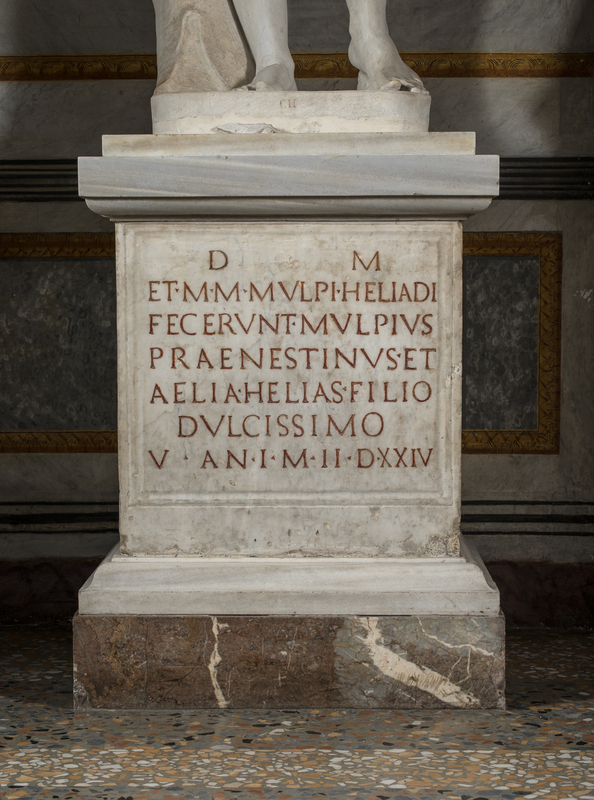Tomb Altar of Marcus Ulpius Heliades
The epitaph on this monument commemorates young Marcus Ulpius Heliades, who died when he was just a year and two months old, and was dedicated to him by his imperial freedmen parents, Marcus Ulpius Praenestinus and Aelia Heliades. The ancient panel, inserted into a modern block, was unearthed in the vineyard of Cardinal Carpi on the Quirinal Hill, where it was depicted in the second half of the sixteenth century in a drawing by Giovanni Antonio Dosio. It was mentioned in its current location in Room II of the Villa Borghese in 1832 by Nibby.
The sculpture is datable to the middle of the second century CE.
Object details
Inventory
Location
Date
Classification
Medium
Dimensions
height cm 55; width cm 56; depth cm 4; height letters cm 3
Provenance
From the collection of Cardinal Carpi (Gruter 1602, p. DCCXVI, no. 4); Borghese Collection, cited for the first time in Room II by Nibby in 1832 (pp. 80–81, no. 7); Inventario Fidecommissario Borghese, 1833, C., p. 46, no. 73. Purchased by the Italian State, 1902.
Inscriptions
D(IS) M(ANIBUS)
ET M(E)M(ORIAE) M(ARCI) ULPI HELIADI(S)
FECERUNT M(ARCUS) ULPIUS
PRAENESTINUS ET
AELIA HELIADES FILIO
DULCISSIMO
VI(XIT) AN(NO) I M(ENSIBUS) II D(IEBUS) XXIV
Conservation and Diagnostic
- 1966 Tito Minguzzi
- 1996-97 Liana Persichelli
Commentary
In the second half of the sixteenth century, the altar was depicted in a drawing by Giovanni Antonio Dosio, now in the Biblioteca Nazionale, Florence, with the inscription ‘nel giardino del Rev.mo Car.le Di Carpi’ (‘in the garden of His Most Reverend Cardinal Carpi’ on the Quirinal Hill (Tedeschi Grisanti 1983, p. 99, no. 60, c). This location was confirmed by Jan Gruter in 1602 (p. DCCXVI, no. 4). Subsequently moved to the Giardini Giustiniani, it was documented in the Villa Borghese in 1832 by Nibby, in its current location in Room II (Tedeschi Grisanti 1983, p. 99, no. 60, c; Nibby, 1832, pp. 80–81, no. 7).
The ancient panel has been inserted into a modern parallelepiped block. The funerary inscription, which is framed by a double incised line, commemorates young Marcus Ulpius Heliades:
D(IS) M(ANIBUS)
ET M(E)M(ORIAE) M(ARCI) ULPI HELIADI(S)
FECERUNT M(ARCUS) ULPIUS
PRAENESTINUS ET
AELIA HELIADES FILIO
DULCISSIMO
VI(XIT) AN(NO) I M(ENSIBUS) II D(IEBUS) XXIV
The epigraph was dedicated by the imperial freedmen Marcus Ulpius Praenestinus and Aelia Heliades to their son Marcus Ulpius Heliades, who died when he was just a year and two months old. Nibby describes it as being used as a base for a statue of Apollo playing the cithara and dates it to the age of Antoninus Pius (1832, pp. 80–81, no. 7). The inscription is included in the Corpus Iscriptionum Latinarum which mentions that it was topped by a relief of a child between a rooster and a tripod (CIL, VI, 4, 1, 29210). The sculpture is datable to about the middle of the second century CE.
Giulia Ciccarello
Bibliography
- J. Gruter, Inscriptiones Antiquae Totius orbis Romani in corpus absolutissimum redactae, 1602, p. DCCXVI, n. 4.
- A. Nibby, Monumenti scelti della Villa Borghese, Roma 1832, pp. 80-81, n. 7.
- Indicazione delle opere antiche di scultura esistenti nel primo piano della Villa Borghese, Roma 1840, p. 14, n. 22.
- Indicazione delle opere antiche di scultura esistenti nel primo piano del Palazzo della Villa Borghese, Roma 1854 (1873), I, p. 17, n. 25.
- Corpus Iscriptionum Latinarum, VI, 1886, n. 29210.
- A. Venturi, Il Museo e la Galleria Borghese, Roma 1893, p. 27.
- Chr. Hülsen, Römische Antikengärten des XVI. Jahrhunderts, 1917, p. 74, n. 172 ff.
- R. Calza, Catalogo del Gabinetto fotografico Nazionale, Galleria Borghese, Collezione degli oggetti antichi, Roma 1957, p. 19, n. 226.
- P. Moreno, C. Stefani, Galleria Borghese, Milano 2000, p. 101, n. 27b.
- P. Moreno, A. Viacava, I marmi antichi della Galleria Borghese. La collezione archeologica di Camillo e Francesco Borghese, Roma 2003, pp. 182, 184, n. 163.
- G. Tedeschi Grisanti, Dis manibus, pili, epitaffi et altre cose antiche, Un codice inedito di disegni di Giovannantonio Dosio, in “Bollettino d’Arte”, 18, 2011, pp. 69-102, in part. p. 87.
- Scheda di catalogo 12/00147835, P. Moreno 1975; aggiornamento G. Ciccarello 2020.


